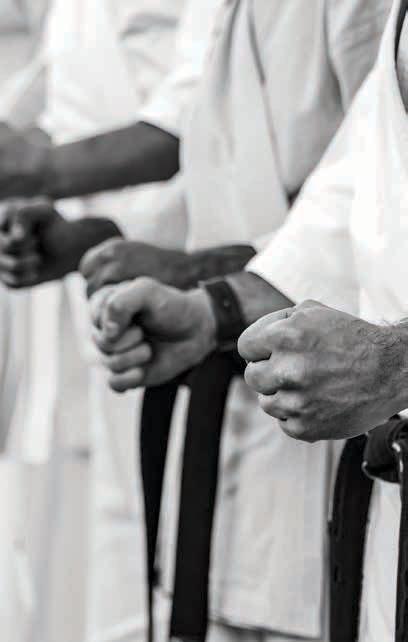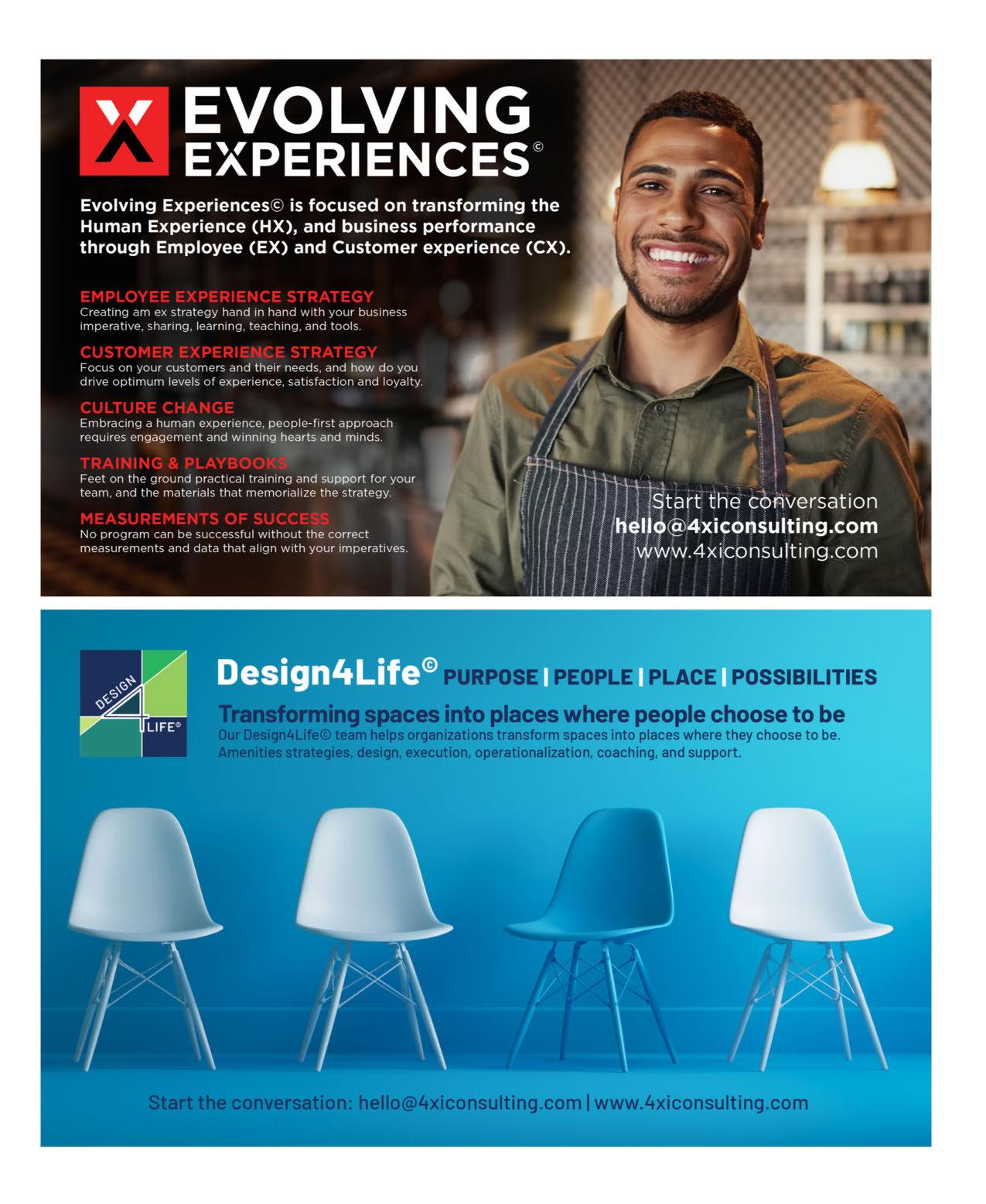
12 minute read
How to Be a Black Belt Leader
LEADERSHIP
How to Be a Black Belt Leader
Two-time Martial Arts Hall of Fame inductee and five-time black belt recipient John Terry shares how to be a success in business and life by becoming a “black belt leader.”
BY LAUREN KIM

WHEN JOHN TERRY WAS THIRTEEN, his family relocated from a big city to a small town in Arkansas. Unfortunately, once he got to his new hometown, he became the target of “every bully in school.” He thought his father would talk to the school principal, but, instead, his dad enrolled him in karate classes to learn how to protect himself.
After a while, the bullies stopped bothering Terry, but not because he used his new karate skills to beat them into submission. Instead, his newfound confidence and leadership abilities from martial arts gave him the strength to approach the bullies and befriend them. “To this day, we are still friends,” Terry says.
Now Terry is the president and CEO of the United States Martial Arts Hall of Fame, a two-time inductee into the hall, and the author of the book Black Belt Leadership 101. He instructs others how to develop the same kind of self-confidence, strength, and leadership to become “black belt leaders,” a selfreflective and empowering process of nine learning exercises that can help those who follow his teachings to transform into better versions of themselves.
The leadership training he provides in his book and online course is imbued with powerful ethics he’s learned during five decades of martial arts. “The martial arts are as much about learning how to live a disciplined life as they are to punch and kick,” he explains. His teachings are predicated on the idea that a big part of leadership involves giving back to those you lead and helping others to become leaders themselves.
“The most important lesson I took from my martial arts journey was learning to lead myself and realizing that the choices I make have consequences in my life,” he says. “If I can learn to lead myself well and make good choices, I have the opportunity for a much better outcome in life. It’s my mission to teach others how to apply the black belt principles I learned to their lives to make a difference.”

Use the guide that follows to develop your own black belt leadership skills.
Belief: The first step to become a black belt leader is developing your confidence and your belief system, Terry says. “You need to believe in yourself, have faith in your abilities, and trust the passion to make the difference you want to make in the world.” If you are a business leader, you may have already started on this leg of your journey.
Learning: Terry is a supporter of lifelong learning. “You need to learn what’s necessary to become a black belt master at whatever your chosen craft, profession, trade, passion, or calling is,” he explains. “You should be a perpetual student.” For instance, he bookends his days with thirty minutes of reading. He suggests reading something inspirational, educational, or biographical. “You should constantly fill your mind with the wisdom, failures, and successes of other people and what they’ve learned,” he says. Additional ways to do this
JOHN TERRY
include taking online courses, attending conferences, and listening to podcasts.
Accountability: Consider finding someone who can push you on your journey to becoming a black belt leader. “You can hire a mentor or a coach, or it can be someone further along in the journey than you are,” he explains. Also, be accountable to yourself and those you lead. “What you say and what you do should be congruent,” he notes. “A leader might expect their employees to clock in at 8:00 a.m., to clock out an hour for lunch, and to clock out promptly at 5:00 p.m. But if the leader doesn’t show up until 9:00 a.m. and strolls around drinking coffee, they’re not

Take Action
Read a book by someone you admire, and learn from their insight and expertise. Make it a habit of bookending your day with inspirational reading.
doing what they expect of others. True leadership models the behavior they want to see in those they are leading.”
Communication: A good leader must communicate well so they can adeptly lead others and share their knowledge. This includes being “an effective listener to hear what people are saying, understand what they are thinking, and know what they need to grow and become a better version of themselves,” he says. Leaders should work on becoming better communicators so people can understand the concept they’re presenting. Consider reaching out to other leaders who can guide you. “Even if someone is just a few steps ahead of you, they have learned things that you haven’t,” Terry explains.
Kinetic: All leaders are people of action. “Leaders are always moving forward, going first, exploring new territory, and doing things that nobody else has done before,” Terry says. “They are the trailblazers.” Sometimes all you need is a boost of confidence to develop that trailblazing ability, just as Terry did so many years ago when he faced his bullies. To get the inspiration you need, you can follow the example of other successful leaders.
Boldness: It’s important for a leader to always be on the move and be courageous. “A leader isn’t passive; they are not going to sit on the sidelines,” Terry explains. It’s the job of a leader to effect change. “It’s very easy for an organization to get caught in the trappings of their early success,” he explains. It’s up to a leader to challenge the status quo and strive to be better at who they are and what they do.
Equipping: As a leader, your role isn’t to exult in your own success—it’s to help others follow your example and become leaders themselves. “You need to equip others with what they need to see success in whatever it is they have been called to do,” Terry says. “If they are going to eventually replace you, you need to pass what you know to them.”
Loyalty: A leader should develop a loyal following and build trust among their followers as well as be loyal to those they are leading. “A leader must be an individual of great character,” Terry stresses. “If they aren’t, they will be a ‘leaderless leader’ because nobody is going to follow them.” A leader should always be serving those they lead and empower them to one day become leaders themselves, he explains.
Transformation: When you progress through all these stages successfully, you will transform into a black belt leader. “If you are spending every day growing yourself and becoming a better version of yourself, over time you will transform,” Terry explains. “Not everybody is going to be a Bruce Lee or Chuck Norris in the ring, but everybody can be a Bruce Lee or Chuck Norris when it comes to learning to discover their own unique gifts so they can become a black belt master at them.” n
For more information, visit beablackbeltleader.com
LEADERSHIP

BELIEVE IN BQ
Discover how your company can benefit by measuring behavioral quotient, a concept championed by revenue-scaling business strategist Mary Grothe.
BY MATTHEW BRADY

I
T’S LONG BEEN THOUGHT that the left brain handles logic and the right brain emotion. But recent research indicates that it’s a bit more complicated than that.
The same holds true for business. An employee’s analytical side, measured by intelligence quotient (IQ), and creative side, measured by emotional quotient (EQ), vie for control of the thoughts they have every day—and more importantly, the actions they take.
To measure and account for this tug-of-war, a third component, behavioral quotient (BQ), needs to be considered. So says Mary Grothe, who coined the term and is the founder and CEO of House of Revenue, a Denver-based company that works with CEOs to build processes and plans to scale revenue. Her team uses BQ to help employers establish benchmarks, find the right employees, and maximize sales for their business.
However, to understand how Grothe’s concept of BQ can help you and your business, you first need to fully understand the terms themselves.

MARY GROTHE PHOTO COURTESY OF MARY GROTHE
A rep with high BQ can make lemonade out of lemons all day long.”

IQ, EQ, and BQ
Intelligence Quotient You’ve undoubtedly heard of IQ, or intelligence quotient, which has been the intelligence standardbearer for decades. When it comes to business, it all comes back to how well an employee grasps everything about their company and industry.
Do they know your products and services inside and out—to the extent that they can anticipate clients’ questions or pain points?
Is your company’s mission like a mantra to them?
Are they an expert on your market, constantly keeping up on the latest trends?
Do they know your competition’s products and philosophy?
If the answer is yes, then their business IQ is likely strong. As a result, clients will see them as credible and trustworthy.
Emotional Quotient In contrast, one’s emotional quotient, or EQ, is about emotions, as the name indicates. The
importance of EQ (sometimes called emotional intelligence or EI) has been emphasized more in business in recent years, and for good reason. By being both emotionally self-aware and cognizant of others’ emotions, such employees are experts at reading the room. As a result, they:
Show that they can put themselves in their clients’ shoes.
Tend to be good listeners.
Know when it’s proper to be assertive or give space.
Know when to ask questions and when to listen.
Emotional quotient is arguably the unsung hero in business. If an employee has strong EQ, they’re more likely to establish strong, personal, long-lasting relationships with clients.
Behavioral Quotient BQ, or behavioral quotient, combines IQ and EQ but, more importantly, is where all the work is done. With behavioral quotient, it all comes down to mindset. According to Grothe, the dominoes positively or negatively

Behavioral Quotient (BQ) in Practice
After gathering all the data you gathered via business intelligence, you give sales goals for the quarter. Note how different mindsets, based on relative BQ, can lead to vastly different results.
Salesperson 1 (low BQ) Salesperson 2 (high BQ)
Mindset:
Not again. These seem unreachable.
Stress. Worry. Gloominess. Frustration.
Half-heartedness. Disorganization. Missed deadlines. Excuses.
Misses goals. Feelings:
Actions: Optimistic. Let’s do it.
Upbeat. Excited.
Sets mini deadlines. Asks questions. Envisions a path for reaching the goal.
Meets/exceeds goals.
Performance:
fall from there in a causeand-effect relationship:
How you think. » How you feel. » How you act. » How you perform.
1. How you think.
How do you process the facts and information presented to you?
2. How you feel.
Do you feel good or bad about that information? 3. How you act.
Do you react positively or negatively based on how you feel?
4. How you perform.
Can you get the job done based on your actions?
Why BQ can make or break a business An obvious question may be, “If an employee has a high IQ and a high EQ,
aren’t they optimized for success?” Not necessarily. An employee can have through-the-roof IQ and EQ but still may not reach their full potential if their BQ isn’t amped up. That’s why BQ is so vital. When it comes to behavioral quotient, a positive mindset and stellar work ethic are the ultimate drivers of success—when an employee consciously decides to give it their all every day, optimal performance will follow.
As Grothe states, “A rep with high BQ can make lemonade out of lemons all day long. The filter through which they see information is all positive to them. They have a high ‘figure-it-out’ factor. They just always get it done. Even when obstacles are in their way, they get creative. They’re risk-takers and problem-solvers.” In contrast, low-BQ people will perceive similar situations as problems, dwell on them, and allow this mindset to drag them down, so they have a more difficult time finding solutions and envisioning what is possible.
How to maximize your team’s BQ As you know, every decision you make for your business should be methodical and intentional, and getting a glimpse into your team is no different. The best part? Based on what you discover about their BQ, you can lead them to a higher, happier, and more productive BQ quotient.
To start the process, set a benchmark to ascertain their mindset. Ask them a series of questions: Do they think they’re set up for success? Are they optimistic about the company and its products? Do they think the workload and/or expectations are reasonable? Do they think they can reach their goals? Do they envision a bright future for themselves and the company?
Then dig into their feelings with questions such as: How motivated are they? Are they confident in themselves and their work? Do they feel like part of a team? Also observe your employees’ actions to determine how selfmotivated they are. You want to get a sense of how much effort they put into things like planning, organizing, and prioritizing, and whether they’re inspired to hit the ground running in the morning and go the extra mile to get the job done. Finally, find out about how they feel about their performance: if they meet their goals and if their performance tends to be consistently high or low (or variable).
By implementing these four principles of BQ and benchmarking the results, you can cull very meaningful information about your team, analyze it, and determine what steps you can take to positively impact them and make your workforce the best it can be. n
For more information, visit marygroethe.com or houseofrevenue.com.
Take Action
Ask questions about how your team thinks, feels, acts, and performs, focusing on their role, tasks, environment, and mindset. Then use what you find to foster strong BQ.

***********AUTO**5-DIGIT 19406 Their Name 1100 FIRST AVE STE 200 KING OF PRUSSIA, PA 19406





